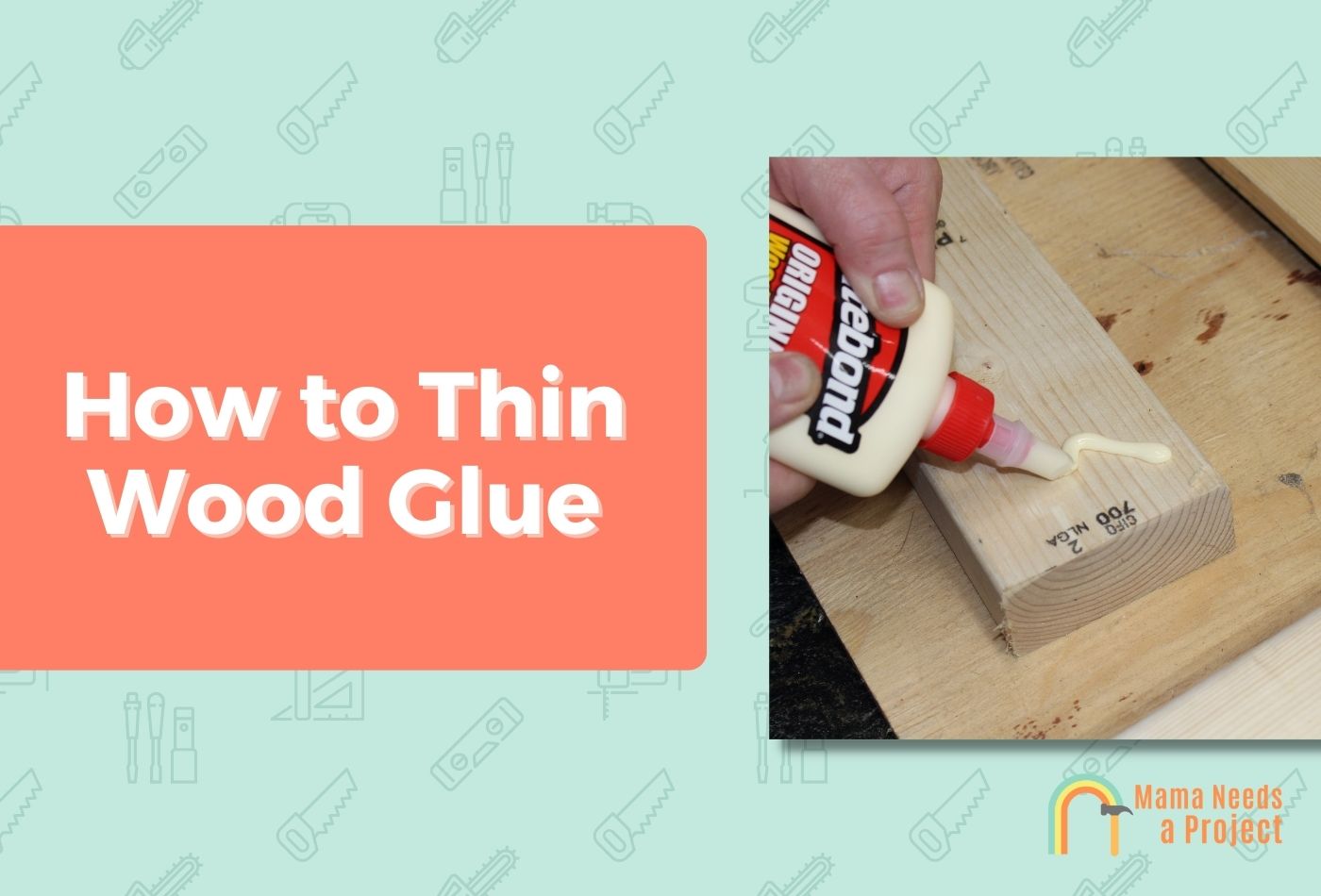How to Thin Wood Glue (4 EASY Methods)
Wood glue is one of the most indispensable supplies in my wood shop.
It’s versatile, easy to use, and an affordable option to bond two surfaces together.
In this post, I’ll show you exactly how to thin wood glue so you can use it over and over again without any problems. Let’s dig in!
- There are three main ways to thin wood glue including using water, vinegar, and heat. These methods will work for any type of PVA glue. Other types of wood glues like polyurethane glues or epoxy glues are a little more tricky and cannot easily be thinned.
- It’s best to store your wood glue in a sealed container in a cool dry place to ensure it doesn’t thicken in the first place.
4 Proven Ways to Thin Wood Glue
1. Use Water to Thin Wood Glue
The easiest way to revive thickened wood glue is to use water to to thin your glue. While this will only work for PVA glues, it’s one of the easiest methods you can try, so I recommend giving it a try before throwing out your glue.
This is an excellent option for a few reasons.
- Water is free!
- It doesn’t smell
- It’s a quick and easy fix
First, you need to ensure your wood glue is water-based. Most wood glue is water-based, but just in case you’re working with gorilla glue or other variation of wood glue, you should make sure you know the base.
Water won’t work to thin non-water-based wood glues (like epoxy wood glues). Once you know the glue is water-based, you can start adding water to thin it out.
Thinning wood glue with water is a simple, yet exact science. You don’t want to add over 5% water to the glue because this will cause the bonding agents in the glue to be diminished.
For this reason, you’ll want to slowly add a little water and mix the glue with. To do this, you can use a wooden chopstick (or something similar) and stir until the water is combined with the wood glue.
You could also place the lid back on the bottle, cover the opening with the cap or your finger, and shake the bottle until the water is incorporated into the glue. If you need to add more water, go ahead; just make sure you don’t add more than 5% to avoid weakening the glue.
2. Use Vinegar to Thin Wood Glue
If you would instead use something a little stronger than water for thinning wood glue, you can also use vinegar. One thing to keep in mind when using vinegar to thin wood glue is “less is more.”
You don’t need to use a lot of vinegar to get the job done, and I recommend using just a couple of drops at a time until the glue is the consistency you want it to be.
Add a few drops of vinegar to your thickened wood glue and stir with your stirring utensil or shake the bottle with the lid secure. Don’t forget to cover the hole in the lid nozzle.
Continue adding a few drops at a time and mixing until it has thinned to the desired consistency for your project.
Tip: You can always add a little water along with the vinegar to help with the thinning wood glue process.
3. Use Heat to Thin Wood Glue
This method is simple and effective.
You’ll take warm water in a bowl or container and place the bottle of wood glue in the water, submerging it. Wait several minutes and remove the glue bottle from the warm water. If the glue isn’t thin enough yet, repeat the process.
This can be tricky because it will solidify if you overheat the glue, so be sure not to keep your wood glue in the hot water for too long.
After all, the water evaporates from the glue. To avoid this adverse effect, follow these simple tips when using heat to thin wood glue.
- Don’t use boiling water. There is no reason to use boiling water. We are gently heating the glue bottle, not trying to cook the glue. You could potentially hurt your hand, and the hotter the water, the more likely you are to thicken the wood glue instead of making it thinner.
- Temperature is key. The water you warm up should not exceed 100 degrees Fahrenheit. An excellent way to gauge the temperature is to keep it around body temperature levels.
- Don’t leave the glue bottle in the water for more than five minutes. To avoid creating a solidified mass of glue, only leave the bottle in the water for a few minutes at one time.
- Mix the glue between baths. After setting the wood glue bottle in the water each time, take it out and shake it gently to incorporate the glue. This will also help you gauge whether the wood glue is ready for use.
It is important to note that this heating technique works best with liquid hide glue but can also be used for water-based wood glue.
Now that we know how to thin wood glue let’s figure out why it thickens in the first place!
4. Try Alcohol
If none of the methods above have worked, you can also try using alcohol to thin your glue.
This method is very similar to using vinegar in that a little goes a long way, so try to limit the amount of alcohol you use as much as possible.
Once you’ve added a couple of drops of alcohol, give your glue a shake or stir until it is mixed together.
Wondering how to use wood glue? Check out the video below!
What Makes Wood Glue Thicken?
Several factors can cause wood glue to thicken. The average shelf life of wood glue after it has been opened is one to two years if it is stored properly. Here’s why wood glue becomes thick over time.
- It gets too hot. Excessive heat thickens wood glue, so storing it in a cool, dry area all year round is best. Some people in the woodworking world keep their wood glue in a fridge to maintain an even temperature.
- It gets too cold. Along the same lines as getting too hot, freezing temperatures are also less than ideal for wood glue. Again, storing it in a cool (not freezing), dry place is best.
- The cap isn’t screwed on tight. Storing wood glue properly is essential to help it last a few years on your shelf. If you don’t screw the cap on correctly, the water evaporates, and the wood glue dries out quickly. Also, make sure that you wipe off any excess glue from the cap and lid to ensure you get a tight seal when closing the bottle.
- Excess air in the glue bottle. Excess air can also dry out wood glue, so squeezing out as much air as possible before sealing your wood glue bottles is important.
FAQs
What Causes Wood Glue to Thicken?
Several variables can cause thickened wood glue. Some of the most common include excessive heat or cold, improper storage, a bad seal of the wood glue lid or cap, or too much air in the bottle. To extend the shelf life, consider using a wood glue dispenser.
How Can You Tell When Your Wood Glue is Past the Point of Saving?
There are several ways to tell if your wood glue is past the point of no return. Yes, we want to try to save the glue, but sometimes there is no salvation for neglected wood glue. Here are a few telltale signs that your wood glue is past saving.
- The glue is hard.
- The glue is stringy and wants to stick to itself.
- The glue has separated and looks like oil and water.
- The glue has turned an orange shade instead of its regular white or cream color.
- The glue has become gummy and lacks moisture.
How to Store Wood Glue to Avoid Thickening
The best way to store wood glue properly is to keep it in a cool, dry place like a basement where the temperature is consistent all year round. Some woodworkers like to keep their wood glue in a refrigerator to maintain a constant temperature. Freezing and excessive heat aren’t good for the longevity of wood glue, so avoid this at all costs.
Also, ensure that your bottles are properly sealed, and all the excess air is removed from the bottle. This will help the glue last as long as possible.
Final Thoughts
It is quite a disappointment when you go to use your wood glue and realize it has thickened since the last time you used it. But depending on the types of wood glue you have, you could save it!
You can often save it and bring it back by adding water, vinegar, heat, or alcohol to the mixture.
However, polyurethane glue or epoxy glues might be a little tougher.
There are many ways we can prevent wood glue from becoming too thick, and with a bit of extra care, you can add a few years to the shelf life of our wood glue.

Miriam Ronne wears many hats, including but not limited to freelance writer, blogger, professional quilter, serial DIYer, and obsessed dog mom. She loves to teach beginners how to do all sorts of crafts and techniques. If she’s not writing her next blog post, she’s either sewing a new project or playing with her pup. You can find Miriam on her blog, Stitch Obsessed, or connect with her on Instagram.

